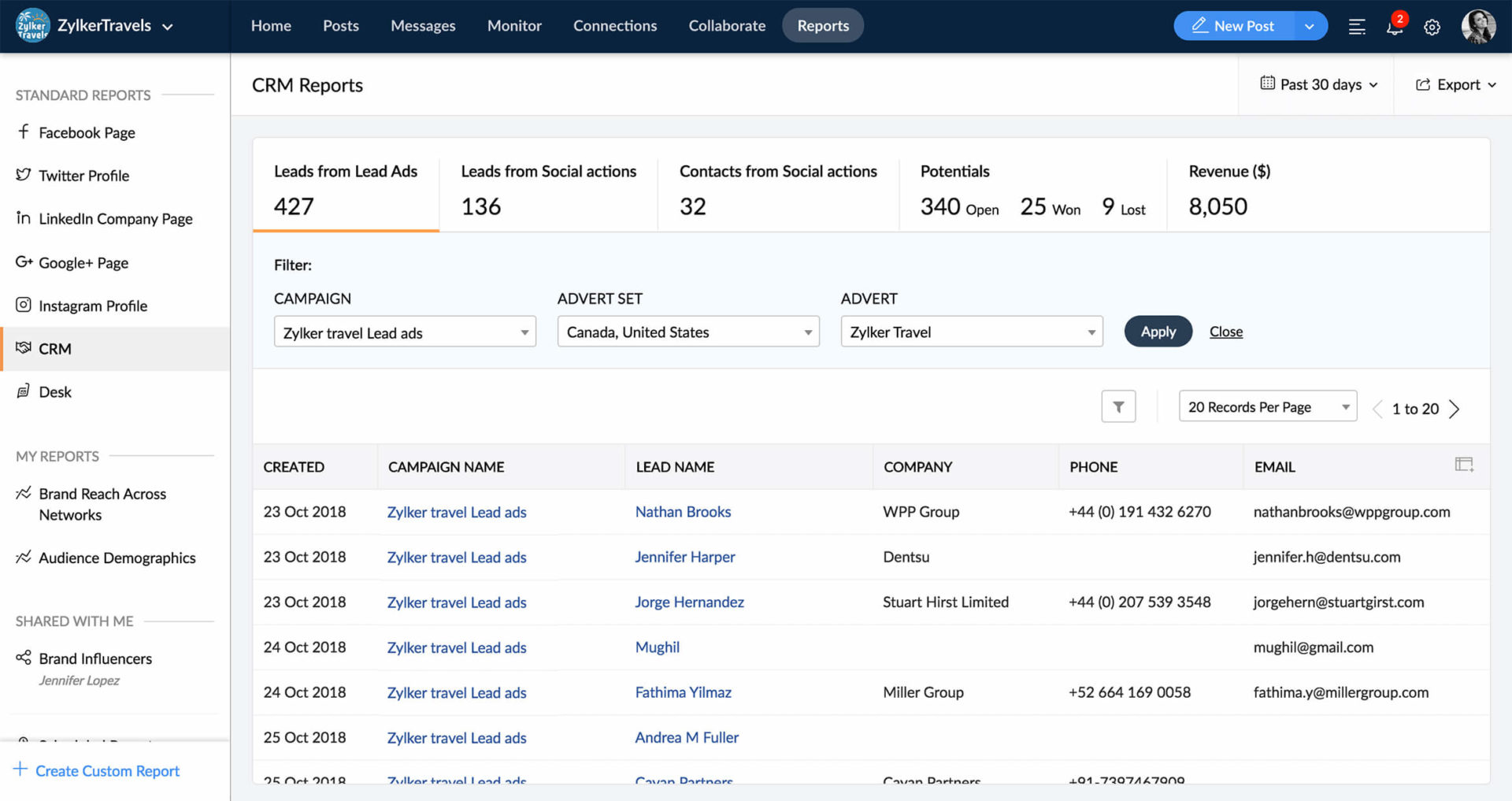How to measure your social media ROI
- Last Updated : August 17, 2023
- 6.0K Views
- 6 Min Read

If you’re reading this blog, I don’t need to convince you that social media is important for your business. You’ve probably already recognized how marketing on social media platforms can give your brand the boost it deserves—but how do you know if it’s actually working or not? While it’s easy to say that all we need to do is to set a goal and then measure if we’re achieving it, how do we really know if the effort we’re putting in is worth it?
That’s where measuring social media ROI comes in.
Before we get started, it’ll be helpful to understand ROI first. ROI is a measure of the efficiency of an investment, and can also be used to compare the efficiencies of different investments.
What that means for social media is that you can not only measure the overall efficiency of your social media marketing efforts, but you’ll also be able to compare your performance on different social channels, such as on Facebook versus on Twitter.
To put it in simple terms, social media ROI is what you get out of all the time, money, and resources that you spend on social media marketing.
Why measure social media ROI?
Measuring social media ROI has a lot of potential benefits for your brand—foremost that it’s a lot more persuasive than just talking. In case you need to convince the stakeholders of your company to pay more attention to social media, or your bosses to allocate larger resources towards social media marketing, nothing works better than pure data. Show them exactly how social media has helped the business, and by how much. This will do a lot more to convince them than any pep talk ever will.
Measuring social media ROI also has other benefits for your brand:
- Gives a clear picture of where your resources are being used most effectively
- Helps identify areas where your resources are being spent inefficiently
- Informs decisions on where resources are to be focused, or where tactics have to be adjusted
How to measure social media ROI?
To measure social media ROI, you need two different numbers:
- Your monetary investment in social media
- Your monetary return on social media
That’s a lot easier said than done, though.
For other activities, it’s pretty easy to identify your return. For example, if your core activity is the production of goods, you’d use sales as the measure of return. However, what do you use as a measure of return for your social media marketing efforts?
That will depend on the overall social media goals you’ve set for yourself.
Some common social media goals for companies are:
- Generating leads from social media
- Brand awareness, i.e, more likes and followers
- Increasing traffic to their websites
- Subscriptions to newsletters
You’ll notice that, apart from the first goal, the rest are all intangibles. Tracking leads is easy, as some tools come pre-integrated with CRM platforms—allowing you to identify which network your lead was generated from and then trace it all the way to the point of sale. If you’re able to do that, then measuring your social media ROI is a piece of cake.

But what happens when your goal is intangible?
Let’s look at that with an example:
Assume that you’ve run a Twitter ad to promote subscriptions to your newsletter. If you’ve spent $100 on this ad, gained ten subscribers, and five of those subscribers bought your products, you have a clear link between the money you spent and the money you made.
In the above scenario, each subscription costs you $10, and each sale cost you $20. Now, depending on the price of the product you sold, you’ll easily be able to calculate your profit, and thereby your ROI from your Twitter ads.
Granted, this is a basic example. In real life scenarios, there are usually a lot of variables at play, and there could be many more stages between the interaction with your social media campaign and the point where the sale is finally made, but the basic principle remains the same. Just keep a close eye on the customer journey, and you’ll find it a little less complex to deal with.
For more accurate results, you can use products like Google Analytics to track your social media performance.
Google Analytics can give you detailed information on which channels are bringing you traffic, but you can get even more granular than that. Google has developed social analytics, and it’s an incredibly powerful tool that you can use to measure your social ROI.
Using Google Analytics, you’ll be able to set specific goals and measure each of them individually. While it might seem intimidating at first, all you’ll have to do is set your goals in the tool and then follow the instructions on the screen.
While you can choose preset templates to make it simpler for you, Google Analytics will also allow you to set custom goals for yourself. There are four different types of goals you can set:
- Destination – Each time someone visits a particular URL, they complete the goal.
- Duration – Each time someone spends a particular amount of time on your site, they complete the goal. You can set the minimum time limit to your requirements.
- Pages/screens per session – You can track the number of pages someone visits in a particular session. You can set the minimum number of pages they’ll have to visit to complete the goal.
- Event – You’ll be able to track specific events on your site, such as video plays, or social media button clicks. You’ll need to add code to your site to do this, but don’t worry—Google has you covered.
For the newsletter example, we can use the destination goal to measure the number of subscriptions we get. A simple way to do this is to take your visitors to a separate “Thank You” page every time they subscribe, and then track visits to that URL. Now you’ll know that every time someone visits that page, they’ve subscribed to your newsletter. Just make sure that the URL isn’t indexed in Google—the only way to land on the page should be through subscribing.
Once you do this, you can assign a monetary value to your goals using past statistical data and compute your social ROI. You’ll need:
- Average number of active users per day
- Total revenue earned per day
- How many days an average user subscribes to your product
Using this data, you’ll be able to compute the average potential value from each customer. If you multiply this with your conversion rate—the average number of newsletter subscribers who become customers—you’ll have the potential value for each subscription to your newsletter.
Of course, this is only based on the example in this post, but you can use similar methods to compute ROI for any other goal that you may have set.
To summarize, here are the steps that you’ll need to go through in order to measure your social media ROI:
- Set clear social media goals. Understand exactly what you’re trying to get out of every campaign that you want to track your ROI for.
- Measure your goals. If your goal was, like we discussed earlier, to increase subscriptions to your newsletter, track how many new subscriptions you make because of your ad campaign. You may consider using Google Analytics to ensure your numbers are accurate.
- Try to assign monetary values to the goals you’ve set. Use data from Google Analytics and past statistical data to arrive at this value.
- Measure the costs involved in the campaign. Apart from the direct cost, that is, the money directly spent on the campaign, it’s also a good idea to include the amount of money spent on associated activities. For example, the amount paid to the copywriters who worked on the campaign and the amount you pay for your social media tools are both relevant associated costs that you can add to your total.
- Now that you have both the cost incurred for and the amount earned from your social media marketing efforts, simply use them to calculate your profit and then your ROI from social media.
Measuring social media ROI is a topic that many marketers struggle with. It’s understandable that it might sometimes seem impossible. If your social media goal is just to get increased visits to your website, or subscriptions to your newsletters, measuring your ROI can seem like a guessing game. However, you’ll find it a lot easier to do if you follow the steps that we’ve listed here.
Have any questions, or know of anything we missed? Feel free to leave a comment below, and we’ll be sure to get in touch with you!
 Vishal
VishalContent writer at Zoho Social, stand up comedian, and lover of dogs. I read a lot.












Comments(1)
that’s great post, yeah social media marketing is power of marketing. almost you need to learn social media marketing of web design services. for more details read this Here